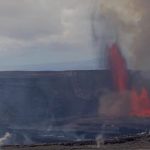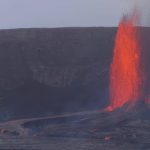Lava skyrockets to more than 700 feet in Episode 15 of ongoing Kīlauea summit eruption
Lava geysers once again skyrocketed from Halemaʻumaʻu Crater inside Kaluapele, the summit caldera of Kīlauea volcano on the Big Island, and at times reaching staggering heights of more than 700 feet Wednesday.

That makes the lava fountains of the most recent active phase — Episode 15 — the tallest yet from the north and south vents in the southwest portion of Halemaʻumaʻu within Hawai‘i Volcanoes National Park since the summit eruption focused there began Dec. 23, 2024.
These fountains also are the highest the volcano has produced since the first 3 years of the middle East Rift Zone eruption of Puʻuʻōʻō eruption, when geysers of molten rock reached upward of 1,500 feet at times from 1983-86, feeding lava flows that traveled downslope.
One of the now 2 livestreams watching Halemaʻumaʻu showed the south vent heaving molten rock high above the cone and crater floor as nearly 2,600 people watched on YouTube at about 11:20 a.m. Wednesday.
Fountain heights have gotten progressively higher since Episode 10 of the eruption from Feb. 19-20, which saw lava geysers of up to 400 feet tall.
Episodes 11 through 14 intensified, with fountains of up to 600 feet or more, and now Episode 15 breaching 700 feet.
Watching the mesmerizing livestreams of Halemaʻumaʻu late this morning, however, made it look like the sky was the limit for how high the fountains could reach as the ongoing summit eruption — which continued as of this writing.
Hawaiian Volcano Observatory and Hawai‘i Volcanoes National Park partnered to install a new webcam with a live view from the northeast rim of the caldera, looking west toward the eruptive vents, to provide a second, different vantage point of the eruption.
This and the original livestream are captured using pan-tilt-zoom webcams that can change their view depending on activity.
Unfortunately, the high lava fountaining is leading to some unwanted — and possibly unhealthy — hazards.
Hawaiian Volcano Observatory continues Kīlauea’s U.S. Geological Survey Volcano Alert Level at Watch.
Hawai‘i County Civil Defense advised in a message shortly after noon that because of the high lava fountaining happening at the volcano’s summit, tephra — any type and size of rock fragment forcibly ejected from the volcano that travels through the air during an eruption, which includes ash, lava bombs and scoria — could be carried north into the Volcano Village and Glendwood areas.

Civil Defense officials said to avoid contact with the volcanic materials and leave the area if you experience respiratory issues.
The agency will provide updates as conditions change.
Hawaiian Volcano Observatory is in constant contact with Hawai’i County Civil Defense and Hawai‘i Volcanoes National Park about activity at the volcano.
Another hazard of primary concern during this eruption is a high level of volcanic gases — primarily water vapor, carbon dioxide and especially sulfur dioxide.
Volcanic gas can have far-reaching effects downwind.
Sulfur dioxide emissions during Episodes 13 and 14 exceeded 40,000 tonnes per day. Similar levels are expected during high fountains of Episode 15.
Winds at the summit are forecast to be weak during the next day, which could allow the eruptive gas plume to spread around Kīlauea’s summit region.
As sulfur dioxide is continuosly released during any eruption, it reacts in the atmosphere to create vog, or volvanic smog, downwind of the volcano. The gas and vog it creates can both cause respiratory and other problems at high concentrations.
In addition, Hawaiʻi Volcanoes National Park visitors and residents of adjacent communities might be exposed to Pele’s hair — strands of volcanic glass produced by lava fountaining activity — and other small fragments of volcanic glass being carried by the plume.
The park also reiterated Hawai‘i County Civil Defense’s message that risks from Pele’s hair and volcanic ash, which can irritate eyes, skin and respiratory systems, have increased because of the lava fountaining associated with Episode 15.
Because of the hazard, the park advises visitors that:
- Uēkahuna Overlook is closed.
- Avoiding being downwind of the eruption is the best option to limit exposure to Pele’s hair and ash.
It also provided these safety tips:
- Limit exposure to avoid being impacted.
- Wear protective gear (glasses, gloves, long sleeves and a mask).
- Rinse off surfaces of vehicles to prevent damage.
- Stay informed and safe by regularly checking alerts on the park website.
Episode 15 began just after noon March 25 with cyclic lava spatter and flows from both vents that continued for more than 10 hours before today’s sustained high fountains began erupting at 10:20 a.m.
Hawaiian Volcano Observatory reports that the lava geysers were preceded by more than 100 cycles of lava rise and fall, vent overflows and spatter fountains in the north vent, a phenomenon known as “gas pistoning,” which has been observed in other Kīlauea eruptions during recent decades.
The south vent was also intermittently active during that time and fed a smaller set of lava flows.
That activity continued mostly unchanged until about 10 a.m. today, when gas pistoning began transitioning to lava fountaining.
The tallest geysers of molten rock from the south vent reaching heights of more than 700 feet by 10:45 a.m. and those from the north vent generally less than half as tall.
Vigorous fountaining activity continued from the south vent just after 1 p.m. as seen on the livestream, increasing and decreasing as the eruptive episode continued into its 25th hour.

Just when you thought it might be waning, the south vent would rev back up. However, by about 1:52 p.m., activity had decreased somewhat from just about an hour prior, and by 2:30 it was even less.
Just minutes later though, the south vent produced a renewed fountain that shot high into the air once again for several minutes prior to this story being published as Episode 15 continued.
Inflationary tilt reached just more than 6 microradians before Episode 15 began, with the summit recovering more than 100% of the tilt it lost during Episode 14, which ended 4 days, 22 hours and 15 minutes before on the afternoon of March 20.
That’s actually the shortest pause period between eruptive episodes since the break between Episodes 6 and 7 from Jan. 26-27, which lasted 2 days, 6 hours and 5 minutes.
The average pause time between episodes since Episode 7 has been 150.59 hours, or just more than 6 days.
Episodes 14 and now 15 have also been two of the longer lasting eruptive phases of the eruption.
Of all the active phases from Episode 5 onward, all but Episodes 12, 14 and 15 lasted less than a day, with only two, Episodes 8 and 9 even getting close at 21 hours, 31 minutes and 22 hours, 27 minutes, respectively.
Episode 14 erupted for 1 day, 4 hours and 23 minutes, or 28 hours and 23 minutes. Episode 15 had already erupted for more than a day and was still fountaining at the time of this writing just before 2:30 p.m. Wednesday; although the lava geyser at the south vent was much shorter than an hour prior.
Seismic tremor at the summit began increasing and decreasing with the cyclic fountains and drainback as Episode 15 began Tuesday afternoon. At the initiation of fountaining today, tilt switched from inflation to deflation, as has been typical in past eruptive episodes; at the same time, tremor increased and became sustained.
The longest eruptive episode since the eruption began just before Christmas last year was Episode 3, which lasted 8 days, 12 hours and 30 minutes from Dec. 26, 2024, to Jan. 3, providing an awesome fireworks show to ring in 2025. The shortest episode so far was Episode 13, which lasted 12 hours, 37 minutes March 11.
Pauses separating active phases of the eruption also have varied in length by a wide margin, with the longest from 8 a.m. to 8:30 a.m. Jan. 3-15 between Episodes 3 and 4, lasting 11 days, 12 hours and 30 minutes, to the shortest break in activity for 16 hours from 4 p.m. to 8 a.m. Dec. 23-24, 2024, between Episodes 1 and 2.
No changes have been detected in Kīlauea’s East Rift Zone or Southwest Rift Zone.
If you want to know what’s happening, there are a few ways you can keep up with the volcano yourself:
- Find Hawaiʻi Volcanoes National Park visitor information.
- Check out Kīlauea webcam images.
- Subscribe to Hawaiian Volcano Observatory daily volcano update and status messages.
- Get a summary of volcanic hazards from eruptions.
- Kīlauea daily activity summary available by phone: 808-967-8862.
Hawaiian Volcano Observatory continues to closely monitor the volcano and will issue eruption status reports when necessary if conditions change.
The volcano observatory will also continue to issue daily volcano updates.
Sponsored Content
Comments
















